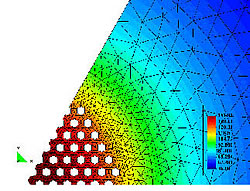Radioactive waste management mathematical modelling tools
In this context, a number of software tools have been developed or adapted: ABAQUS, CODE_BRIGHT, COMPASS, CASTEM 2000. They have been applied to the simulation of a number of "in situ" experiments carried out in various Underground Research Laboratories. The same tools are useful to predict the future behaviour of the repository systems, both in the short and the long term. The codes developed are based on the Finite Element Method and are able to perform coupled thermo-hydro-mechanical analysis in two and three dimensions for problems involving porous media. They ensure the conservation of mass of the various species considered as well the conservation of energy and momentum. The generalised behaviour of the materials under changes of temperature, relative humidity and stresses are described by means of constitutive laws appropriate for the materials involved in each specific analysis. By solving numerically the relevant equations, the variation of the basic thermo-hydro-mechanical variables over time can be readily be obtained. The codes have been used in the analysis of large scale in situ tests performed as part of a number of EC-funded projects such as RESEAL, BAMBUS, FEBEX, PROTOTYPE, EB. They have also been checked, compared and validated in the framework of several benchmark projects like CATSIUS-CLAY and EVEGAS.



